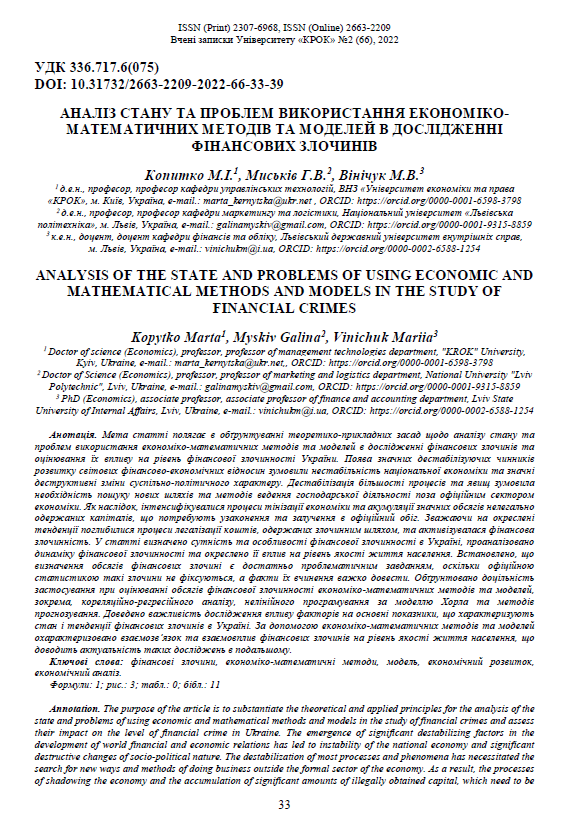ANALYSIS OF THE STATE AND PROBLEMS OF USING ECONOMIC AND MATHEMATICAL METHODS AND MODELS IN THE STUDY OF FINANCIAL CRIMES
DOI:
https://doi.org/10.31732/2663-2209-2022-66-33-39Keywords:
financial crimes, economic and mathematical methods, model, economic development, economic analysisAbstract
The purpose of the article is to substantiate the theoretical and applied principles for the analysis of the state and problems of using economic and mathematical methods and models in the study of financial crimes and assess their impact on the level of financial crime in Ukraine. The emergence of significant destabilizing factors in the development of world financial and economic relations has led to instability of the national economy and significant destructive changes of socio-political nature. The destabilization of most processes and phenomena has necessitated the search for new ways and methods of doing business outside the formal sector of the economy. As a result, the processes of shadowing the economy and the accumulation of significant amounts of illegally obtained capital, which need to be legalized and put into official circulation, have intensified. Taking into account the outlined tendencies, the processes of legalization of proceeds from crime have deepened and financial crime has intensified. The article identifies the essence and features of financial crime in Ukraine, analyzes the dynamics of financial crime and outlines its impact on the quality of life. It has been established that determining the amount of financial crimes is quite a problematic task, as official statistics do not record such crimes, and the facts of their commission are difficult to prove. The expediency of using economic-mathematical methods and models in estimating the volume of financial crime, in particular, correlation-regression analysis, nonlinear programming according to the Horl model and forecasting methods is substantiated. The importance of studying the influence of factors on the main indicators that characterize the state and trends of financial crimes in Ukraine is proved. Using economic and mathematical methods and models, the relationship and interaction of financial crimes on the quality of life of the population is characterized, which proves the relevance of such research in the future.
Downloads
References
Лотфі Заде Нечітка множина. Вікіпедія – вільна енциклопедія. 2022. URL: https://uk.wikipedia.org/wiki/%D0%9D%D0%B5%D1%87%D1%96%D1%82%D0%BA%D0%B0_%D0%BC%D0%BD%D0%BE%D0%B6%D0%B8%D0%BD%D0%B0
Янковий О. Г. Багатомірний аналіз в системі Statistica : монографія. Одеса: Оптиум, 2001. 216 с.
Янковий О. Г. Латентні ознаки в економіці: монографія. Одеса: Атлант, 2015. 168 с.
Руденко В. Математична статистика : навчальний посібник. Київ : Центр учбової літератури, 2012. 304 с.
Гуран І. Й., Гутік О. В. Математика для економістів-міжнародників: підручник. Київ : Знання, 2008. 388 с.
Копитко М. І., Вінічук М. В., Верескля М. Р. Економіко-математичні методи та моделі в системі зміцнення соціальної компоненти економічної безпеки України. Фінансово-кредитна діяльність: проблеми теорії та практики, 2017. №2 (23). С. 302–312
Авдійський В. І. Тіньова економіка і економічна безпека держави: навчальний посібник. Москва .: Альфа-М, 2010. 496 с.
Варналій З. С., Жаліло Я. А. та Флейчук М. І. Тіньова економіка: сутність, особливості та шляхи легалізації: монографія. Київ : НІСД, 2006. 576 с.
Єдиний звіт про кримінальні правопорушення за 2016–2020 рр. Офіційна сторінка Офісу Генерального Прокурора України. URL: https://www.gp.gov.ua/ua/stat_n_st?dir_id=114140&libid=100820#.
Quality of Life Index by Country, 2012–2021. URL: https://www.numbeo.com/quality-of-life/rankings_by_country.jsp?title=2021&msclkid=7b13595fbbf011ecb1b0caa38c0ba637
Тіньова економіка: загальні тенденції січень–вересень 2021 року: аналітична записка Міністерства економіки України. Київ, 2022. 14 с. URL: https://me.gov.ua/Documents/List?lang=uk-UA&tag=TendentsiiTinovoiEkonomiki&showArchive=true.

Downloads
Published
How to Cite
Issue
Section
License
Copyright (c) 2022 Kopytko Marta, Myskiv Galina, Vinichuk Mariia

This work is licensed under a Creative Commons Attribution 4.0 International License.

